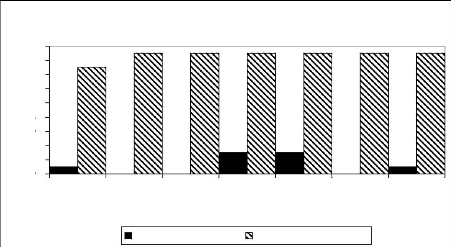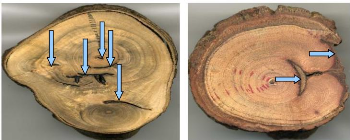4.3. Fire regime analysis from tree -rings of
investigated species
4.3.1. Fire master chronology in CNP and UAC
The analysis of fire scars on investigated stem discs with
dendrochronology techniques helped to have the master fire chronology in both
sites as experienced by sampled tree that was presented in Figure 14 and 15.
Fire history in Comoe National Park
Number of scarred
tree

4
2
6
5
3
0
1
Forest border (A. leiocarpus, N = 8) Savanna (D. microcarpum, N =
10) Forest (D.abyssinica, N = 8)


Year
Figure 14: Fire history in Comoé National
Park as experienced by sampled trees. In Common
legend, N means the number of tree analyzed for each species.

Number of scarred tree
18
16
14
12
10
4
2
8
6
0
1995 1996 1997 1998 1999 2000 2001
Fire history in Upper Aguima Catchment
Number of scarred tree Number of tree analyzed
Year
Figure 15: Fire history in Upper Aguima
Catchment as experienced by sampled trees.
4.3.2. Fire interval
In Comoé National Park, 19 different fire dates were
identified. The earliest fire of 1976 was recorded on two D. abyssinica
trees (D1-105 and D1-108). The first tree germinated in 1971 and has only
one fire scars and the other one germinated in 1974 with two different fire
scars. The recent fire in this park was recorded in 2001 on D. microcarpum
(DE-103; DE-105) and A. leiocarpa trees (AN-103; AN-105). The
highest number of fire scars was observed on D. abyssinica tree
(D1-104) that had five different fire scars (1981, 1985, 1987, 1990 and 1 992)
followed by one of A. leiocarpa tree (AN-104) which was scarred at
four different years (1988, 1991, 1995 and 1999).
Specifically, D. abyssinica trees that were collected
from forest area in CNP allowed us to date fire from 1976 to 1997. During this
p eriod, the fire interval varied from one to four years. Most of sampled wood
of D. abyssinica had their youngest fire scars before 1993. In 1997,
only two samples were scarred by fire. After this year, no fire scars was
observed on sampled cross wood of this species, indicating that fire
experienced by the sampled tree in forest of Comoé National Park was
restricted from 1997. This area was probably protected against fire by
technical forest management disposition.
About fire history in forest border, we estimated it from
A. leiocarpa samples from 1985 to 2001, the year before collecting
samples. It was estimated to be between four and six years until 2001. Thus, we
conclude that forest border of CNP was always treated by fire. A. leiocarpa
was described in CNP by Klaus (2006) as pioneer species. Thus we suppose
that the forest border was cleaned for fire breaks building. This observation
confirms the hypothesis that from 1997, forest area of CNP was protecte d
against fire. Its effectively was proven since 1997.
Concerning savanna area of this park, the fire past was
reconstructed from D. microcarpum species. All sampled trees for this
species were originated after 1985 and the earliest fire date in this area was
from 1992. From this year to 2001, the fire in terval varied between one and
five years. That could be a positive management action either for ensuring
grazing for herbivorous mammals or as to facilitate tourism. However, the
regular use of fire in CNP savanna area could also be due to the destructive
pressure of poachers during game searching.
In upper Aguima Catchment, the oldest tree collected from this
second studied area was twelve years old in 2002. The fire interval was from
1995 to 2001 with four different dates (1995, 1998, 1999 and 2001). On any of
samples, we identified more than one fire scar. However, like all samples were
collected in open mosaic forest, we can reconstruct fire history in this area
by dating the fire scar for each sa mple as shown in the figure 9. Thus, fire
interval in open mosaic forest of Upper Aguima Catchment was estimated between
one to three years. However, the all estimated fire interval depend of the
sampled tree that could escape fire event during the supposed -non fire period
even if bush fire occurs on year round cycle.

Figure 16: Example of different year's fire
scars on wood stem discs
| 


